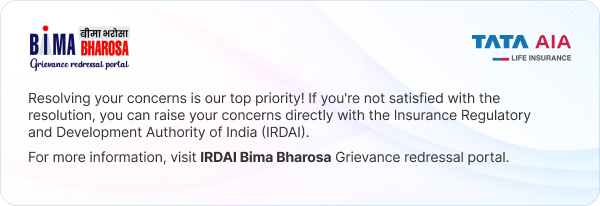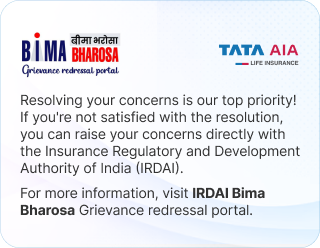What is an Endowment Plan in Life Insurance?
An endowment plan is a type of life insurance that offers both financial protection and a savings component. It provides a lump sum payout either at the end of the policy term or in the event of the policyholder's death. In simple terms, it acts as a savings tool with the added advantage of life insurance coverage for your family. If you are looking for life cover along with a savings component, this plan might be suitable for you. In this article, you will understand what is endowment plan, how it works, its key benefits, types and more.
What is an Endowment Policy?
Let’s first look at the endowment plan meaning. An endowment plan is a type of life insurance that offers life coverage as well as a savings component. It means that the policy will provide financial protection to the policyholder's family in the event of their unfortunate death. Over the course of the policy term, it will also help accumulate savings for the future.
Premiums for endowment plans must be paid periodically during the policy term. The beneficiaries of an endowment insurance policy will receive a death benefit if the policyholder passes away during the active period of the policy. After the policyholder lives through the policy term and the policy remains active, a maturity benefit is paid out as a lump sum.
How Does an Endowment Policy Work?
Now that you understand the definition of endowment policy, let’s explore how it works. An endowment plan offers both a death benefit and a maturity benefit, provided you pay all your premiums on time.
In case of death during the policy term: Your family will receive the death benefit, which is the sum assured agreed upon at the start of the policy. Along with this amount, they may also get certain yearly additions or other bonuses2, depending on the terms of the policy.
If you survive the policy term: You will receive a maturity benefit, which is the assured amount payable at the end of the policy term. Additional benefits, such as assured yearly additions and loyalty additions, may also be applicable based on the policy features.
Here is an example to understand the working of an endowment policy:
Assume an individual takes an endowment plan for 20 years with a sum assured of Rs.10 lakh. If the policyholder passes away during the 20-year term, the family receives Rs.10 lakh along with any bonuses or additional benefits offered by the policy.
If the policyholder survives the full term, a maturity amount of Rs. 10 lakh is paid out, along with any applicable bonuses. Thus, this plan provides financial protection for the family in case of death and also helps in building savings over time.
Types of Endowment Policy
It is important to understand the different types of endowment plans before purchasing one. You can choose from different types of endowment plans based on your financial needs:
Plan |
Description |
Unit Linked Endowment Plan
|
● The premium you pay for unit linked endowment plans is divided into two parts.
● A part of the funds is invested in your life insurance policy, and the other part goes toward investment funds. |
Guaranteed Endowment Plan
|
● Under this plan, the policyholder receives guaranteed1 benefits.
● At maturity, the policyholder receives both the sum assured and loyalty additions, if any have been received.
● In addition to that, they will receive: Guaranteed sum assured at maturity, plus Guaranteed yearly additions, plus Guaranteed loyalty addition |
Full/With Profit Endowment Plan
|
● Policyholders get the amount they were assured when they bought the policy.
● A bonus will impact the final payout, including the surplus, depending on whether the insurer declares a bonus. |
Low-cost Endowment Plan
|
● This policy allows the insured to accumulate funds, which are usually paid after a certain period of time.
● The purpose of this plan is to help policyholders build a corpus that will protect their future or help them pay off their loans and mortgages.
● In the event that the policyholder passes away while the policy is active, the nominees or beneficiaries will still receive the sum insured. |
Non-profit Endowment Plan |
● These endowment plans do not participate in the gains of the life insurance company, so they offer guaranteed1 additions instead of bonue insurer. |
What are the Key Factors of an Endowment Policy?
The following are the key factors affecting an endowment plan:
Age: Due to their perceived low risk, young people typically pay lower insurance premiums than older people.
Gender: Insurance premiums for women are generally lower than those for men.
Medical Records: In the calculation of the life insurance premiums, past and present illnesses are considered to estimate potential future illnesses that may affect coverage in the future.
Family History: Families with serious health issues, such as heart disease or cancer, can affect premiums, as it suggests a greater likelihood of similar health issues for the policyholder
High-risk Activity: A high-risk activity, like smoking, alcohol consumption, and high-risk habits, can increase insurance premiums.
Policy Terms: A higher coverage amount and longer policy term usually result in higher premiums as the insurer's liability increases.
Premium Payment Frequency: Whether you choose monthly, quarterly, or annual payments can affect the total cost and cash flow flexibility.
Bonus Structure: Participating endowment plans may offer reversionary and terminal bonuses, which depend on the insurer’s performance and surplus distribution.
Riders and Add-ons: Optional benefits like critical illness or accidental death riders can enhance coverage but also raise the premium.
Surrender and Loan Provisions: Early surrender may lead to lower returns, while loan facilities can provide liquidity but reduce the final payout.
Benefits of an Endowment Plan
Endowment plans are good insurance policies if you wish to enjoy the dual benefits of life cover and long-term guaranteed1 returns in a single policy.
Death benefit + survival benefit: Under endowment insurance, if the insured meets an untimely demise, their beneficiary is entitled to the sum assured. However, if the policyholder outlives the policy term, then they receive the accumulated savings corpus (plus bonuses, if any) as a maturity benefit.
Multiple Premium Payment Frequencies: The policyholder can choose the frequency of the premium payment as per the policy they have opted for. The payments can be made on a monthly, quarterly, half-yearly, or annual basis.
Flexible Cover: The coverage of an endowment plan can be extended or enhanced with the help of riders#, such as total permanent disability, accidental death, critical illness, etc. These riders are included in the base plan if the policyholder feels the coverage should be enhanced.
Tax* Savings: A policyholder can avail of the tax benefits for their endowment plan as per the applicable tax laws. The premium payments of the policy are eligible for tax benefits under Section 80C, while the maturity amount and death payout are eligible for tax benefits under Section 10(10D) of the Income Tax Act, 1961.
Who Should Buy an Endowment Policy
An endowment plan is well-suited for anyone who has long-term goals and wants to save for the future while also having life insurance. These plans can be a suitable option for those looking to save up for their children's college education, buy a dream home, or save for retirement.
However, before choosing a plan, you must determine your financial objectives and how much risk you are willing to take. If you are primarily concerned with returns that are secure and risk-free, a traditional endowment plan may meet your needs. You may want to consider a unit-linked life insurance plan if you can afford to take on more risks for better returns.
What to check before buying an endowment policy?
Here are a few simple parameters that can help a first-time policy buyer understand how to buy a new endowment plan:
The policyholder's goals: It is necessary to consider your requirements and financial objectives, especially long-term goals, before purchasing an endowment plan. Since these plans provide significant returns, they are well-suited if you seek to meet financial goals such as retirement planning, your child's higher education or their marriage, the purchase of a new car, and so on in the later years.
Features of the Endowment Plan: There are different types of endowment policies which vary in terms of the coverage they offer, the savings or investment option, the premium payment modes, and the options in riders#. Before buying one, always examine and compare different plans and choose one that aligns with your needs. For example, you can opt for a regular premium plan only if you have a steady and regular flow of income. A single premium plan can be better for someone whose income is not fixed.
The need for an endowment plan: Policyholders can choose endowment plans for the assured returns they offer on the savings over the long term. These savings can help one meet some major expenses and financial emergencies in future. However, many others who seek life insurance cover along with savings are also in favour of endowment plans. There are also those who avail of such plans because of the tax* benefits offered. However, it is not wise to purchase life insurance plans solely for tax* benefits
Endowment Plan vs Money Back Policy
Money-back plans and endowment plans both offer death and maturity benefits. However, these plans differ in the following ways.
Parameters |
Endowment Plan |
Money-Back Plan |
Meaning |
A life insurance plan that offers both life cover and savings for the future. |
A life insurance plan that provides life cover along with periodic payouts. |
Duration |
10 to 30 years. |
15 to 20 years. |
Death Benefit |
Death benefit is available |
Includes a death benefit |
Maturity Benefit |
A lump sum amount is paid after the policy term ends if the policyholder survives. |
Regular payouts are made during the policy term, with a final lump sum at maturity. |
Nature of Payout |
Policyholders or the nominee receive a lump sum amount |
The payout is disbursed in instalments |
Loan Facility |
A loan can be availed once the policy acquires a surrender value. |
A loan facility is generally not available. |
Suitability |
Suitable for those aiming to save for long-term financial goals. |
Suitable for those who want periodic payouts to meet short-term financial needs. |
Endowment Plan vs Term Insurance Plan
Here is how an endowment plan differs from a term plan:
Parameters |
Endowment Plan |
Term Plan |
Meaning |
A type of life insurance plan that offers life cover along with a savings component. |
A pure protection plan that provides life cover for a specific period. |
Purpose |
Offers both life protection and a savings opportunity to achieve long-term goals. |
Provides financial protection to dependents in case of the policyholder’s death. |
Duration |
10 to 30 years. |
10 to 40 years; some plans offer coverage up to the age of 99. |
Maturity Benefit |
Provides a guaranteed1 maturity benefit if the policyholder survives the policy term. |
No maturity benefit. However, some plans offer a return of premiums option on survival. |
Affordability |
Premiums are generally higher compared to term plans due to the savings component. |
Term plans are among the affordable life insurance options. |
Sum Assured |
Usually lower, as part of the premium goes towards savings. |
High sum assured, as the plan focuses purely on life protection. |
Nature of Payout |
Lump sum paid on maturity or in case of the policyholder’s death. |
Lump sum paid only in case of the policyholder’s death during the policy term. |
Bonus |
Bonuses2, like loyalty additions and yearly additions, may be provided. |
Bonuses are not applicable. |
Loan Facility |
A loan can be availed after the policy acquires a surrender value. |
The loan facility is not available. |
Suitability |
Can suit those looking to save for long-term goals while having life cover. |
Tends to suit individuals seeking affordable protection for their family’s financial security. |
Endowment Plan vs ULIP Plan
The following is the difference between ULIP and an endowment plan:
Parameters |
Endowment Plan |
ULIP |
Meaning |
A life insurance plan that offers life cover along with savings. |
A life insurance plan that combines life cover with market-linked investment opportunities. |
Purpose |
Provides financial protection and disciplined savings for future goals. |
Offers life cover along with potential wealth creation through market investments. |
Lock-in period |
Does not have a lock-in period |
Has a 5 years lock-in period |
Maturity Benefit |
Assured lump sum along with bonuses, if any, at the end of the policy term. |
The fund value based on market performance is paid at maturity. |
Fund Switching |
Not permitted |
Fund switching is permitted |
Bonus |
Yes, bonus is available |
No, bonuses are not provided |
Suitability |
Suitable for individuals seeking stable, low-risk savings with life cover. |
Suitable for those looking for life cover along with higher potential gains through market-linked investments |
Conclusion
Endowment plans enable building a fund corpus, offering savings alongside a life cover. You can fund children's education, buy a home, or do retirement planning. A suitable plan, considering one’s age, medical history, etc can offer the desired coverage along with death and survival benefits. Tata AIA Life Insurance offers several Savings Solutions wtih dual benefits of life cover and guaranteed1 savings. You can explore Tata AIA Life Insurance Endowment Plans for guaranteed1 returns, various riders#, flexible premium payment modes and frequencies, loan against policy and tax benefits as per prevailing norms.
Get in touch with us today for more details.











 FOR EXISTING POLICY
FOR EXISTING POLICY 
 FOR NEW POLICY
FOR NEW POLICY 








